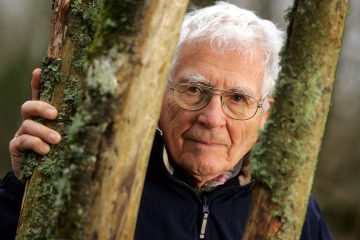Table of Contents
- Exploring the Gaia Theory and Its Origins in James Lovelocks Vision
- Understanding the Interconnectedness of Life and Earth Through Gaia
- James Lovelocks Contributions to Environmental Science and Climate Awareness
- Practical Applications of the Gaia Theory in Modern Conservation Efforts
- The Legacy of James Lovelock: Shaping Our Future Through a Holistic Worldview
- Q&A
- In Conclusion

Exploring the Gaia Theory and Its Origins in James Lovelocks Vision
The Gaia Theory, initially posited by James Lovelock in the 1970s, presents a revolutionary perspective on Earth’s biosphere as a self-regulating entity. Lovelock perceived the Earth not merely as a collection of biological and mineral components but as a complex, interconnected web of life that functions cohesively to maintain conditions suitable for life. His vision was inspired by the idea that organisms interact with their inorganic surroundings in a manner that perpetuates the conditions for life, implying a form of consciousness in Earth’s ecosystems. This perspective was simultaneously scientific and philosophical, urging us to rethink our relationship with the planet.
Key to understanding Lovelock’s theory is the notion that life on Earth is intertwined through feedback mechanisms. These mechanisms include:
- Atmospheric Regulation: Organisms like plants contribute to oxygen production and carbon dioxide absorption, influencing atmospheric composition.
- Climate Stability: The presence of living organisms helps regulate temperatures and maintain stable climates through processes such as transpiration.
- Biodiversity: A diverse range of species enhances ecosystems’ resilience, ensuring their ability to adapt to changes or disruptions.
While Gaia Theory has garnered both acclaim and skepticism, its significance in understanding environmental dynamics cannot be overstated. Lovelock’s ideas have prompted interdisciplinary dialogue across ecology, philosophy, and climate science. They push for a holistic view of nature, urging policymakers, scientists, and individuals alike to recognize the interdependence between humanity and the Earth. The legacy of Lovelock’s vision continues to inspire movements advocating for environmental sustainability and a deeper respect for the planet’s ecosystems, emphasizing the urgent need for collective action as we face the climate crisis.

Understanding the Interconnectedness of Life and Earth Through Gaia
The concept of Gaia, formulated by James Lovelock, posits that the Earth functions as a self-regulating, complex system that incorporates both living organisms and their inorganic surroundings. This idea challenges traditional scientific paradigms that view life and the environment as separate entities. Instead, it emphasizes their interconnectedness, suggesting that the biosphere actively participates in maintaining the conditions necessary for life. According to Lovelock, this interaction is not merely a passive process; rather, organisms are integral to the Earth’s systems, influencing climate, atmospheric composition, and even ocean chemistry.
Gaia theory introduces several critical components that underpin this intricate relationship:
- Feedback Loops: Biological processes create feedback loops that can have far-reaching impacts on the planetary system. For instance, the increase in plant life can enhance soil quality, which in turn supports more plant life.
- Homeostasis: Similar to a living organism, the Earth strives for equilibrium. For example, the regulation of carbon dioxide levels helps stabilize temperatures, crucial for sustaining diverse ecosystems.
- Co-evolution: Life and the environment evolve together. Many species have adapted to conditions molded by other living beings, illustrating a profound level of dependency and interaction.
This perspective calls for a holistic view of environmental issues. Recognizing the Earth as a living entity encourages sustainable practices and underscores the importance of protecting biodiversity. By understanding that our actions reverberate through this interconnected web, we can cultivate a deeper respect for our planet. A collaborative approach that integrates ecological health and social responsibility is critical in addressing the pressing challenges of climate change and environmental degradation. Embracing Gaia’s vision inspires a responsible stewardship of the Earth and urges humanity to consider its role within this expansive and delicate system.

James Lovelocks Contributions to Environmental Science and Climate Awareness
James Lovelock, the pioneering scientist behind the Gaia hypothesis, revolutionized our understanding of Earth as a self-regulating system. Through his extensive research, Lovelock argued that the biosphere and physical environment interact in such a way that they maintain the conditions necessary for life. This bold assertion shifted perspectives within environmental science, emphasizing the interconnectedness of all living organisms, their habitats, and the atmosphere. His innovative approach has led to significant discussions on how ecological balance is fundamental in combating climate change.
In addition to the Gaia hypothesis, Lovelock made substantial contributions through various inventions, including the development of the electron capture detector. This device transformed environmental monitoring by enabling scientists to detect trace gases—such as the greenhouse gas methane—at incredibly low concentrations. His work in this area has played a pivotal role in identifying the impact of human activities on climate. Lovelock’s commitment to empirical research, coupled with his engagement in public discourse, has positioned him as a key figure in raising awareness about climate issues.
The implications of Lovelock’s work extend beyond theoretical frameworks, inspiring action and advocacy in environmental movements. His writings often emphasize the urgency of addressing climate change and the necessity for a change in societal values towards nature. Key points from his contributions include:
- Interconnected Systems: The idea that natural systems are intricately linked.
- Human Impact: Analyzing how human activity disrupts ecological balance.
- Climate Advocacy: Urging individuals and governments to adopt sustainable practices.
Practical Applications of the Gaia Theory in Modern Conservation Efforts
The Gaia Theory, proposed by James Lovelock, posits that the Earth functions as a self-regulating system where biotic and abiotic components interact closely to maintain conditions conducive to life. This holistic view has profound implications for modern conservation practices. By recognizing the Earth as a complex, interconnected organism, conservationists are better equipped to develop strategies that prioritize the health of entire ecosystems rather than isolated species. This approach encourages an understanding that the decline of one species can have cascading effects throughout the ecosystem.
In practice, the Gaia Theory fosters initiatives aimed at restoring and preserving biodiversity. Projects focused on rewilding, for instance, emphasize reintroducing native species to bolster ecological balance. Such efforts not only protect individual species but also aim to restore ecosystem functions that maintain the health of the planet. Examples of these initiatives include:
- Ecological restoration: Rehabilitating degraded habitats to promote biodiversity.
- Collaborative conservation: Engaging local communities in preserving and managing ecosystems.
- Integrated land-use planning: Creating land-use policies that reflect ecological interdependencies.
Moreover, the integration of Gaia principles into conservation policy is transforming how governments and organizations approach environmental challenges. By employing adaptive management—a structured, iterative process of decision-making—theories can be applied to dynamically adapt to changing ecological conditions. This process ensures that conservation actions are flexible, informed by continuous feedback, and grounded in real-world ecosystem interactions. For instance, the establishment of protected areas now often aligns with key ecological dynamics, thus fostering resilience against climate change and anthropogenic pressures. This shift reflects a more nuanced understanding of the natural world’s complexity and interdependence.

The Legacy of James Lovelock: Shaping Our Future Through a Holistic Worldview
James Lovelock’s contributions to environmental science extend far beyond the original concept of Gaia, a theory that posits that Earth’s biological and inorganic components interact to create a self-regulating system. This holistic perspective has transformed how we view the relationship between humanity and nature, urging us to adopt a more integrated approach to environmental challenges. As a scientist and a visionary, Lovelock emphasized the importance of understanding ecological systems not as isolated fragments but as interconnected webs, where the health of one aspect directly impacts another.
Throughout his career, Lovelock advocated for a shift in human consciousness concerning our role on this planet. His work has led to significant dialogue and action regarding climate change, sustainability, and the preservation of biodiversity. By promoting ideas such as the importance of biomimicry and sustainable practices, he encouraged various sectors—from agriculture to urban planning—to reevaluate their impact on the planet. Lovelock’s legacy provokes us to consider long-term ecological health in our decision-making processes.
As future generations grapple with the pressing issues of climate change and ecological decline, Lovelock’s holistic worldview remains a beacon of hope. Embracing his principles can guide policy formation and personal lifestyles directed towards sustainability. Below is a summary table highlighting key concepts derived from Lovelock’s work that can guide our actions today:
| Concept | Description |
|---|---|
| Self-Regulation | Understanding the Earth’s systems regulate themselves for balance. |
| Interconnectedness | Recognizing the web of life connects all organisms and environments. |
| Sustainability | The need for patterns and practices that meet present needs without compromising future generations. |
| Biomimicry | Learning from nature to innovate sustainably in various fields. |



0 Comments